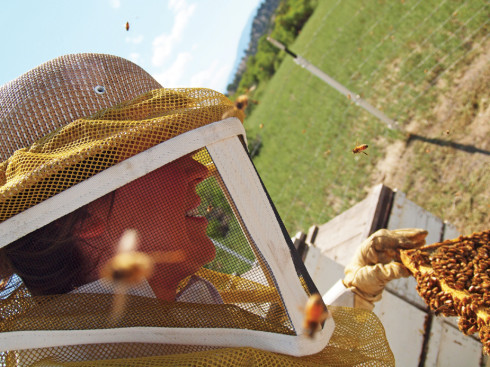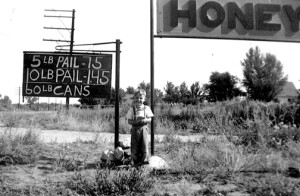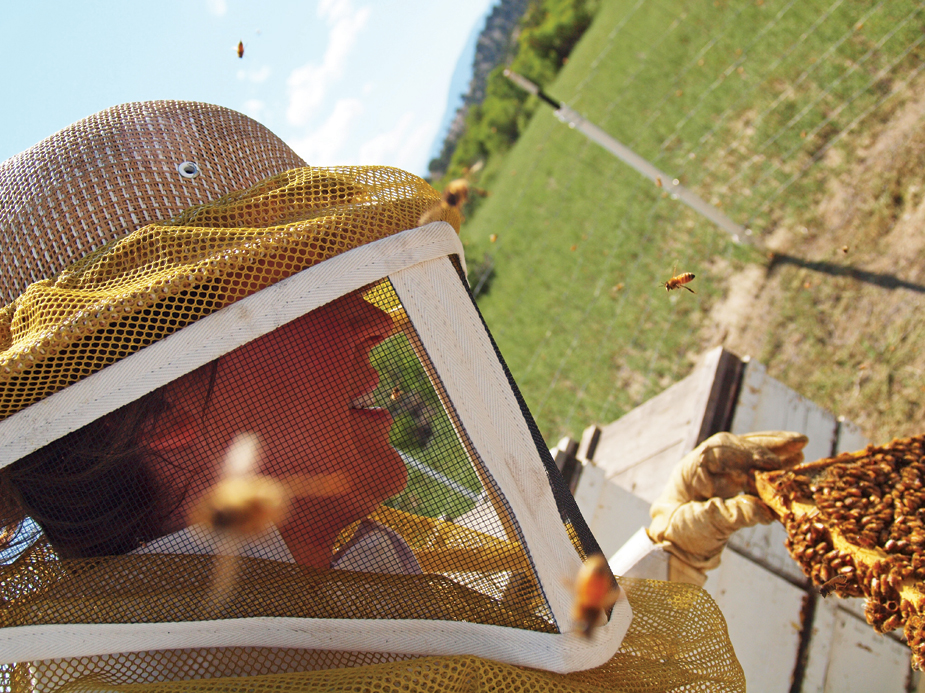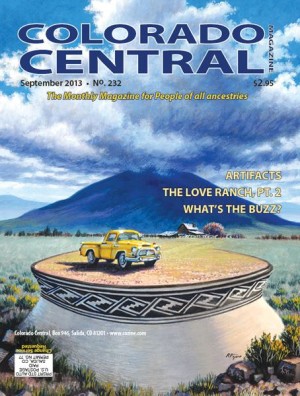By Ericka Kastner
I felt alive (dare I say buzzed?) as I pulled away from Jamie Johnston’s beeyard of nearly 2,400,000 honeybees off County Road 160 near Salida. The murmur of the bees’ song echoed in my ears, and I smiled as I drove, pondering the possibility of establishing my own small-scale hobby hive to pollinate my backyard garden.
Draped in beekeepers’ veils and coveralls, Jamie and I chatted about bee biology, the science of honey making and her family’s rich history in beekeeping as she checked the hives for the timing of the honey harvest.

Jamie is a fourth-generation beekeeper and a bona fide member of the oldest bee operation in the state of Colorado. Beekeeping in the Johnston family dates back more than 100 years to great-grandfather Walter Leckenby’s 1908 beeyard in Fort Lupton.
Jamie’s grandfather, Arthur Johnston, turned beekeeping into a sweet family tradition, and Jamie’s father Lyle began working the bees when he was eight or nine years old.
“His parents put him on the school bus in the morning, and when he’d arrive at school he would get off the bus and walk right back home to work the bees with his dad. He knew from a young age that was what he wanted to do,” Jamie recalls.
As a teenager, Lyle split the bees and the family business and moved to Rocky Ford with Jamie’s mom, Toni, to put the bees on cantaloupes and melons in the region.
Now retired, Lyle and Toni live in Salida lending Jamie a hand in the honey house. Lyle’s reputation as the largest and best bee broker in the state of California confirms Jamie’s assertion that her dad “doesn’t really know how to retire.” Each year, from October to May, he and Jamie move 60,000 hives, trucked in by beekeepers from across the U.S., to pollinate almond and orange crops in the golden state.
Two of Lyle’s three brothers, Larry and Gary, also keep bees in Colorado. Larry works hives in Las Animas, and Gary is still operating the same honey house in Fort Lupton that their grandfather launched two generations earlier.

In 2008, Jamie purchased 300 hives from her father. She says beekeeping today takes a lot of work. In the early days, keepers set up hives and left the bees alone to wander their usual two-mile range, pollinating at will. Now hives have to be moved for beekeepers to turn a profit, sometimes by the keeper and sometimes by pollination services.
“There are a lot of crops in the United States, and a large percentage of them need bees,” Jamie points out. The widespread use of chemicals and pesticides has contributed to the endangerment of bees and has created a need to move bees away from treated areas to protect the hives.
Since bees became endangered in the U.S., beekeepers that used to ship 8,000 hives to Jamie and her father in California each year now only ship between 1,000 and 2,000 hives.
Jamie oversees 20 beeyards in Colorado and says there’s not as much need to protect her bees from chemicals here, because most local farmers don’t use the pesticides that are harmful to them. She and her bees follow the bloom, however, and she joins her 860 hives in their annual “migration” to California each fall, working sometimes as many as 18 hours a day.
Jamie laughs as she considers that as a young girl, her consequences for back talking her parents or for a broken curfew typically included working the bees, and now she does it for a living.
She remembers her dad instructing her to take the life of a queen bee after the queen had laid eggs in a hive for a year. Jamie says she would plead with him to give them more time to live.
“I would say to dad, ‘I think that one has a few more years in her,’ and his reply was always the same, ‘If you can’t squish that queen, you’d better find another job.’”
Although she had always been fascinated by bees, Jamie once doubted her ability to make a living by beekeeping. For a time, she did find another job in the office of Economic Trade and International Development at the Denver World Trade Center. Her eyes twinkle a bit when she reminisces on the day she found herself being called back to the honey house.
“I looked out the window of my high-rise office and thought, ‘I wonder what the bees are doing right now?’”
Beeyond the Hive’s Salida location on West Third Street is the honey house’s first retail store. Since Jamie and her siblings, Jacy and Jeff, began the business in 2005, packaging honey out of Loveland and Fort Collins, they’ve become the largest wholesale distributor of Colorado honey.
She and Jacy observed that most beekeepers are middle-aged men, so Beeyond the Hive founders made one of their main objectives to make it “fun, funky and trendy to be interested in bees.”
The team divides the work according to their skillset; Jamie makes the honey, Jeff distributes it and Jacy markets it.
Jamie makes raw clover, alfalfa and wildflower honey, in both filtered and unfiltered varieties. She says the wildflower honey has the strongest following among local honey aficionados because of its short, seasonal run, varied flavor from year to year, and limited availability.
The Johnstons’ Colorado honey is now found in Noosa Yogurt, Udi’s Granola and Great Harvest Bread Company stores across the state. Jamie says it’s challenging to keep up with the demand. Nothing is wasted in the honey harvest – wax separated from the honey is used to make Beeyond the Hive soaps, lotions and candles.
The rare experience of sitting in an alfalfa field on an August morning, surrounded by millions of bees inadvertently posing for their very own photo shoot, isn’t something I’ll quickly forget. Entering the inner circle of the bees and their keeper left me feeling privileged and expanded my horizons. Since then, I’ve periodically found myself wondering what the bees are up to.
After all, as Jamie so aptly puts it, “There is always something with the bees.”
Logophile and wordsmith Ericka Kastner has chosen writing as her primary art form since she was stricken with a fondness for her first thesaurus at age 10. She finds herself extraordinarily lucky to be paid to write professionally. In her free time, Ericka welcomes bees to her garden and licks honey from her fingers at her home in downtown Salida.



